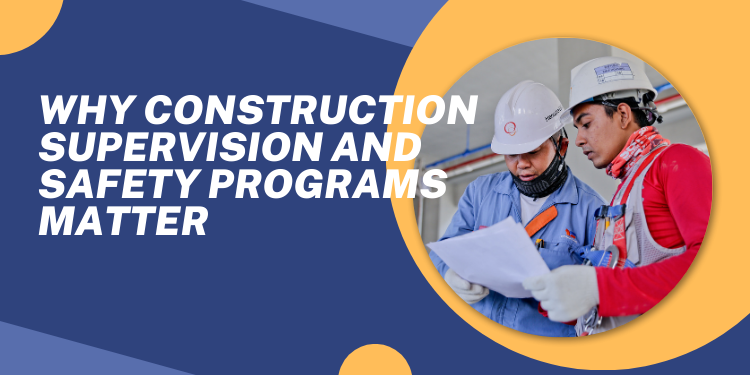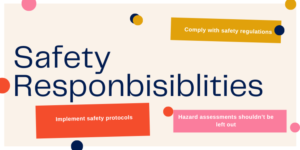Construction supervision and safety programs are important components in addressing construction hazards, yet they are sometimes perceived as mere formalities rather than essential practices.
Beyond their immediate impact on worker safety, well-implemented safety programs have long-term benefits for the organization’s projects. They help to reduce accident-related costs, such as medical expenses and legal fees, among others that we’ll be discussing in detail.
Investing in comprehensive safety measures and effective supervision ultimately leads to a more productive and successful construction process.
Let’s start with why construction supervision and safety programs are important.
Why are construction supervision and safety programs important?
Here are some key reasons why construction supervision and safety programs are important:
1: Project efficiency and productivity
Accidents or unsafe practices can lead to project delays and downtime, affecting overall productivity. A safe work environment allows for smooth operations and timely project completion.
Workers who feel safe are more likely to be productive and remain with the company. High morale leads to better work performance and lower turnover rates.
2: Protect lives and prevent injuries
The primary reason safety matters in construction is to protect the lives of workers. Construction sites are inherently dangerous, with risks from heavy machinery, falls, electrical hazards, and more. Ensuring safety means preventing fatalities and serious injuries.
Companies have a legal and moral obligation to provide a safe working environment. Failing to do so can lead to severe consequences, including legal actions and loss of reputation.
3: Gives good reputation and business success
A strong safety record improves a company’s reputation among clients, stakeholders, and potential employees. Companies known for prioritizing safety are more likely to win contracts and maintain long-term business relationships.
Clients are more likely to engage with companies that have a proven track record of safety. This trust can lead to more business opportunities and partnerships.
4: Innovation and technology adoption
The focus on safety drives the adoption of new technologies and innovative practices in the construction industry. This includes the use of drones for site inspections, wearable technology for monitoring worker health, and automated machinery, all of which contribute to safer work environments.
5: Financial implications
Accidents can lead to significant financial losses through medical costs, compensation, insurance premiums, and delays in project completion. A strong safety culture reduces these risks and associated costs.
Companies with poor safety records often face higher insurance premiums. Maintaining a strong safety record can lower these costs and make the company more competitive.
6: Compliance with regulations
Governments and regulatory bodies impose strict safety standards for the construction industry. Non-compliance can result in hefty fines, legal actions, and even shutdowns of construction projects.
Adhering to established standards, such as those from OSHA (Occupational Safety and Health Administration) in the U.S., ensures that construction companies operate within the law and maintain industry best practices.
How to Improve Safety on Construction Site
There are several ways to improve safety on construction sites which include:
1: Comprehensive safety training
Conduct mandatory safety training for all workers, covering site-specific hazards, emergency procedures, and equipment use, while ensuring that all are certified for specific tasks like operating heavy machinery or handling hazardous materials. Additionally, provide continuous education on new safety protocols and technologies.
2: Inspect site
Implement regular safety inspections by qualified personnel to identify potential hazards, using detailed checklists to ensure all aspects of the site meet safety standards, and immediately address and rectify any issues found during these inspections.
3: Use Personal Protective Equipment (PPE) properly
Enforce strict policies requiring the use of appropriate PPE, including helmets, gloves, boots, and safety goggles, and conduct regular checks to ensure this equipment is in good condition and properly used. Additionally, provide PPE that is both suited to specific tasks and comfortable for workers to wear.
4: Proper equipment maintenance
Schedule regular maintenance and inspections for all equipment to prevent malfunctions and accidents, ensuring that all machinery is operated according to the manufacturer’s guidelines. Additionally, allow only trained personnel to use the equipment and replace any outdated or worn-out tools that could pose a safety risk.
5: Ensure clear communication
Hold daily meetings to discuss ongoing tasks, potential hazards, and safety reminders, and use clear, visible signage to warn of hazards and guide safe practices around the site. Additionally, establish a system that allows workers to report unsafe conditions anonymously.
6: Prioritize worker’s health and well-being
Create schedules that avoid overworking and include sufficient rest periods. Provide resources for mental health support to help workers handle stress and psychological challenges. Conduct regular health check-ups to ensure workers are physically fit for duty, particularly for high-risk tasks.
7: Build safety culture
Site managers and leaders should make safety a top priority and set an example through their actions. Implement programs that recognize and reward safe practices, motivating workers to take responsibility for their own safety and that of their colleagues. You should also create an environment where safety issues can be addressed openly without any fear of retaliation.
8: Regulatory compliance
To ensure safety, comply with local, state, and federal regulations as well as industry standards. Maintain detailed records of all safety training, inspections, incidents, and corrective actions. Additionally, engage third-party safety auditors to offer an unbiased review of site safety practices.
Implementing these methods collectively can create a safer construction environment, reducing accidents, and injuries, and improving overall site productivity.
Up next, we’ll be looking at challenges to effective programs.
Challenges to Effective Safety Programs
Here are some of the key challenges to having an effective and comprehensive safety program on construction sites:
1: Cost and resource constraints
Developing and implementing safety programs can require significant financial investment, which smaller companies may find burdensome. Companies might lack the necessary equipment, technology, or skilled personnel to effectively implement safety programs.
2: Cultural and behavioral challenges
Some workers may resist safety programs due to a belief that safety procedures slow down work or are unnecessary. If management does not prioritize safety, it sends a message that safety is not important, leading to poor adoption at all levels.
3: Complexity and bureaucracy
Navigating complex regulations and ensuring compliance can be overwhelming, particularly for smaller firms. The paperwork and ongoing monitoring required for safety programs can be time-consuming and may be seen as a distraction from core activities.
4: Training and education gaps
Lack of comprehensive training programs can result in workers being unaware of safety procedures or not knowing how to apply them correctly. In diverse workforces, language differences can hinder effective communication of safety protocols.
5: Inconsistent in safety rules enforcement
Inconsistent enforcement of safety rules can undermine the effectiveness of safety programs, as workers may not take the rules seriously. Without clear accountability measures, safety violations may go unaddressed, leading to an unsafe work environment.
6: Dynamic work environments
The constantly changing nature of construction sites can make it difficult to standardize safety practices. Unforeseen risks, such as changes in weather or unexpected site conditions, can complicate safety program implementation.
7: Subcontractor challenges
Managing safety across multiple subcontractors, each with different safety cultures and practices can be challenging. Disparities in safety standards among subcontractors can create inconsistencies in program implementation.
8: Pressure to meet deadlines
The pressure to meet deadlines can lead to cutting corners on safety measures. In highly competitive markets, companies may underbid and subsequently have fewer resources available for safety initiatives. Implementing a safety program in the construction industry often encounters various barriers.
By addressing these barriers with targeted solutions, construction companies can create safer work environments, reduce accidents, and improve overall project outcomes.
Conclusion
To sum up, the challenges of the construction industry demand a proactive approach to safety, where effective supervision and well-implemented safety programs are key components.
Are you ready to invest in your team’s safety?




